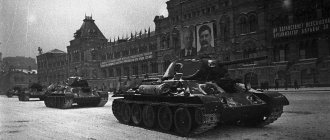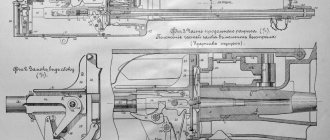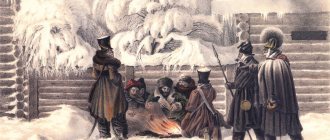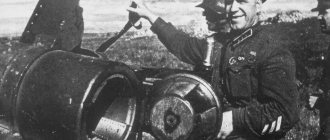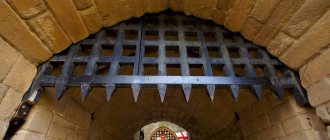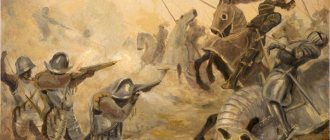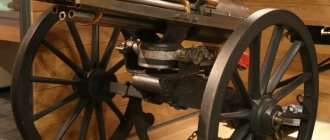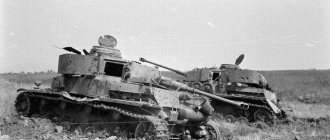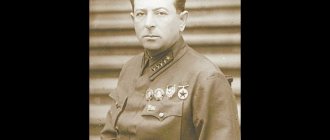Their modern descendants are so far removed in technical terms from their ancestors that now centuries-old designs often evoke a condescending smile. However, the vehicles that went on the attack on September 15, 1916 seemed to contemporaries and were in fact at that time the focus of the most modern technologies, the highest achievement of military-technical thought, which radically changed, along with aviation and automatic weapons, the nature of combat operations, the weapons system and the organization of armies .
The first armored vehicles were assembled from tractors
In general, before the war, European armies needed, rather, a more or less efficient vehicle capable of towing heavy weapons over rough terrain.
Reference
The tank owes its birth to the British Colonel Dunlop Swinton. He was the first to notice that the US-made Holt crawler tractor moved easily over rough terrain thanks to its wide track spacing. The tests that took place in February 1915 disappointed the military acceptance, since the tractor, covered with armor, failed to budge.
© Archive photo of Dunlop Swinton and Benjamin Holt in Stockton with a Holt crawler tractor (right) and a model of a British tank (left).
California, April 22, 1918 However, the idea of using an armored vehicle had to be returned. We owe this largely to Winston Churchill, who, then holding the post of First Lord of the Admiralty, instructed the Imperial Defense Committee to begin developing design documentation for a new combat vehicle.
The urgent need for a tank as a tool for breaking through a layered defense line and supporting advancing infantry arose only as a result of a positional deadlock. As is known, the maneuverable period of hostilities ended in the West in December 1914 with the formation of continuous lines of trenches, covered with wire barriers and machine-gun fire, which thwarted any attacks. From that moment on, the appearance of a tank was already a matter of time. And the British were the first to achieve this goal.
The engineers of Foggy Albion went to their goal by trial and error. After all, no one had a single view on “land battleships”. After long discussions, the military formulated the technical specifications: bulletproof armor, compact dimensions, crossing craters with a diameter of up to 3.7 m and a depth of up to 2 m, overcoming a ditch 1.2 m wide and wire barriers, speed of at least 4 km/h, cruising range up to 6 hours, crew up to 6 people, cannon and two machine guns.
An engineering company in Lincoln (Lincolnshire), which had experience in assembling Hornsby tracked tractors and also produced heavy wheeled tractors for artillery, undertook to fulfill the order. The talk was about developing a machine using the power unit of the Foster-Daimler heavy tractor and the chassis of the American Bullock tractor.
Reference
Of the three solution options - a cable track, a reinforced belt made of surrogate rubber, a link track with a rigid suspension - the project participants chose the latter. The track rollers, drive and idler wheels with a track about 500 mm wide were mounted on a separate armored box frame.
© Photo from the archive
A variant of the car called "Little Willie".
"Little Willy" and the "Royal Centipede"
By September 28, 1915, the wooden model was completed, and at the end of November a new version of the machine was prepared for testing. He became known by the nickname "Little Willie".
Reference
The vehicle had a mass of 18.3 tons, a crew of 4-6 people, a length without tail of 5.45, a height of 2.41 and a width of 2.8 m, and a hull wall thickness of 6 mm. 105 hp engine and a two-speed gearbox provided speeds of up to 3.2 km/h (reverse - 1 km/h). A 7.7-mm Vickers machine gun was installed in the frontal plate of the hull; there were hatches on the sides for firing personal weapons. The hole for the tower was plugged with a lid.
“Little Willie” overcame a ditch up to 1.52 m wide, in which he was helped by a wheeled tail copied from the “wheeled cart” of the Holt and Bullock tractors, a wall 0.6 m high and a rise of up to 20°.
However, British engineers considered that this was not enough. As a result, they came up with the idea to give the contours of the caterpillar a parallelogram shape, and to increase the height of the toe, put the upper branch on top of the body. A rotating turret would have raised the vehicle’s center of gravity too much, so they decided to place the weapons “naval style” - in the side sponsons, that is, protruding side casemates.
The redesigned car was called "Big Willie". It was also called the “royal centipede.”
© Photo from the archive
Assembly of the Big Willie (Mark I) tanks at the W. Foster plant in Lincoln.
So who won?
From a tactical point of view, despite the losses, the French were successful. They completed the task of containing the Germans until the main forces occupied the defensive line. From an operational point of view, it's exactly the opposite. Hoepner's task was to attract the enemy's attention to the plateau. And he did it brilliantly, chaining the best corps of the French army to a secondary direction. The Germans had ten tank divisions, the French only three DLMs and three DCRs (a different type of tank division, smaller in size and generally less successful in structure). Gembloux had two DLMs in operation, so it is not surprising that the French simply had nothing to plug the huge hole at Sedan.
Tanks are preparing for the first battle
The decision to launch the first tanks into battle came to the attention of the British commander-in-chief Douglas Haig against the background of the slippage of the offensive - the German positions almost did not suffer from artillery strikes, the Kaiser’s troops remained combat-ready. The British spent a lot of wasted effort trying to break through the defenses.
At the same time, Haig was very wary of the new product, but the situation at the front did not leave him much choice. Haig was convinced that he had chosen the wrong time to attack. Bad weather has turned the battlefield into a quagmire, and the tanks need solid ground. Finally, and this is the most important thing, the total number of combat vehicles produced was not enough for a massive offensive. But still, it was decided to take a risk.
Reference
The Mark I armored vehicles went into the first tank battle. Unlike the prototypes, which were assembled from boiler iron or rolled non-armored steel, the Mk I hull was made from sheets of rolled armor 5-12 mm thick.
Production began with sheets of mild steel being cut, holes drilled into them for rivets, then hardened and secured with angles and steel strips using bolts and rivets.
The Admiralty allocated naval 57-mm (6-pound) Hotchkiss guns with a barrel length of 40 calibers for tank builders. Why the Admiralty? Because the ground generals did not support “Churchill’s adventure” (as they called the development of the first tank design bureau) and did not believe in the effectiveness of tanks, and therefore were not going to spend their arsenals on this “pointless undertaking.”
© pinterest.co.uk
Cutaway view of a Mark I tank.
Reference
The rate of fire of the naval Hotchkiss was 15-20 rounds per minute, the effective firing range was up to 1,800 meters. The gun was mounted in a sponson on a pedestal mounting. Its rotating part rested on a fixed base with a combat pin and was fixed with a connecting ring. A rule lever was used for aiming, fire control was carried out by a pistol grip with a trigger, and a side shield protected the gunner from the moving breech. The sponson embrasure was covered by a cylindrical shield connected to a rotating part and having vertical cutouts for a gun and an optical sight. The cutout for the gun was covered by a shield attached to the cradle.
It should be clarified that the cylindrical shield often jammed when bullets, small fragments or just stones got between it and the walls of the body. 57-mm rounds (332 pcs.) were placed in the lower part of the sponsons and on racks between the side walls, and 6,272 machine-gun cartridges were placed in boxes on the inside of the installation shields. The gunner fired from the cannon while kneeling on a wooden floor, a kind of raised sponson floor, under which spare parts, tools and accessories were laid (spare parts, tools and accessories. - Ed.). During the rollback, the gun breech almost reached the engine hood. The spent cartridges were thrown out through a hole in the bottom of the sponson door.
© Photo from the archive
Naval 57 mm (6-pounder) Hotchkiss gun on a Mark I armored boat.
Reference
In addition to cannons, the tanks were armed with 3-4 Hotchkiss machine guns, the production of which the British began in Coventry in 1915.
The commander fired from the frontal machine gun. The machine gun embrasures were equipped with hinged covers. At the back of the sponson there was a door with external hinges, and a step was attached under the door.
There was also a hole in the roof of the hull and a narrow door in the aft wall on the right, behind the radiator. Hatches with external flaps were made on the sides of the sponsons and wheelhouse for firing from personal weapons. Revolvers were considered an important weapon - crews underwent special courses in shooting them. The crew of the car consisted of eight people.
Interestingly, British industry produced two types of Mark I. Sharp-tongued soldiers nicknamed them “male” and “female.” The first type was armed with both cannons and machine guns. It was intended to break through enemy defenses during a breakthrough. The “female” went to cover the “male” and was armed only with machine guns to destroy enemy personnel.
Strengths of the parties
On the same topic
How the French introduced the fashion for wheeled tanks
The French had two tank divisions - a total of about 20,000 people, more than 400 tanks, as well as several dozen very good Panhard 178 armored cars. Moreover, if the H-35 and H-39 tanks could, although not always, be hit by German 37-mm cannons, the Somua S-35s were low-vulnerable, but they could easily hit any German armored vehicles. Artillery was represented by forty-eight 75 mm cannons and the same number of 105 mm howitzers. There were several dozen anti-tank guns with a caliber of 25 mm and 47 mm, which easily penetrated all German tanks.
The Germans had two tank divisions. In terms of artillery and infantry, the German divisions were superior to their French counterparts. The Germans had more than six hundred tanks, but among them only 82 Pz.III and 50 Pz.IV. The rest is “ones” and “twos”. If we reduce everything to a comparison of millimeters of armor and guns, then the Germans should not have had a chance at all. The Somuas alone should have given them a tank pogrom.
Baptism of fire
A unit of 49 Mark Is, which would engage in the first tank battle, moved to the front line in the dark. The steel masses crawled like turtles in the direction where the sky was constantly illuminated by signal flares. After three hours of marching, only 32 vehicles arrived at the places indicated for concentration: 17 tanks got stuck on the road or stopped due to various problems.
At dawn the German trenches appeared. The soldiers sitting in them were amazed at the sight of the strange machines. Surprise, however, did not prevent the Germans from opening hurricane rifle and machine-gun fire on the tanks. However, it turned out to be ineffective, especially at long and medium distances. Clumsily waddling, the tanks continued their approach, terrible in its inevitability. Having reached pistol range, the steel death machines themselves opened fire from their cannons and machine guns.
© Photo from the archive
British tanks attack.
The Germans hoped to the last that the slow armored vehicles would get stuck in the multi-row wire fence installed in front of the trenches. However, the thorn did not stop the tanks. They easily wound it around their tracks. And then panic began in the German trenches. Many soldiers left their positions without permission and rushed to the rear. Others raised their hands in surrender. Following the tanks, hiding behind their armor, came the British infantry.
The first tank duel in history
Sooner or later this was bound to happen. A tank, this “creeping fortress” for breaking through defenses, simply could not help but one day encounter the same “fortress,” only an enemy one. This first happened on April 24, 1918 near the Belgian village of Villers-Bretonneux.
The first German tank - A7V
The A7V tank is the only type of German tank created during the First World War
The Germans were the last to build their tank and therefore tried to take into account the shortcomings of British and French vehicles. As a result, the German A7V tank turned out to be so well protected that out of 20 vehicles built, only 4 were destroyed in battle. Another 3 fell into the hands of the Allies: 2 stuck and 1 overturned. The frontal armor was three times thicker than that of British tanks and was 30 mm. Moreover, the plates were located at different angles of inclination.
Thanks to all this, the A7V's armor was not penetrated by armor-piercing bullets and even withstood a direct hit from a projectile with a steel shrapnel cup.
Placement of crew members and ammunition in the A7V tank:
- Commander.
- Driver.
- Machine gunners.
- Mechanics.
- Gunner.
- Charging.
- Box for 180 shells.
- Box for 15,000 rounds.
Sudden meeting
The mentioned village of Villers-Bretonneux, although small, was of great importance in the circumstances of that time. The Germans threw all their available A7V tanks here. On the morning of April 24, three A7V tanks of the German assault unit met three British Mk IV tanks of the 1st British tank battalion that emerged from the forest. The meeting was completely unexpected.
Wilhelm Blitz - commander of the German A7V tank number 561, which entered into the first tank duel in history
Frank Mitchell - British tank commander, participant in the first tank duel
Static defense versus maneuver
Two out of three British tanks had machine guns, and this became a problem. Both, struck by shells from German tank guns, with their sides torn apart, barely crawled to the rear. The British cannon "Mark" remained on the battlefield under the command of Lieutenant Mitchell. And then the German tank commanders stopped to take better aim. Moreover, they blocked each other’s view, so that the battle was actually fought only by tank No. 561 of Lieutenant Blitz. The English tank constantly maneuvered and fired from short stops. Now this is a classic tank battle. Lieutenant Blitz responded to 3 hits on his A7V tank with a direct hit on Lieutenant Mitchell’s Mark tank.
The British tank stood up with a torn track, but all three German tanks decided it was best to move to the rear. In essence, it was a combat “draw”. However, since the battlefield remained with the British, they declared themselves winners in the first tank battle in history.
Results of the first battle
Soon the tank attack ended. Only 18 vehicles returned from the battle under their own power to the rear, 5 tanks were stuck in the swamp, and 9 had damaged engines.
At the same time, the effect of the first tank offensive in world military history was very high. The British managed to wedge into the enemy’s defenses five kilometers deep and the same length along the front. Previously, up to 8,000 people were lost to capture one square mile. The skeptic General Haig, who had seen the light, immediately after the battle sent a telegram to London demanding that 1,000 more of these machines be ordered.
The effect produced by the first “land battleships” on soldiers and officers of all warring sides allowed World War I participant Erich Maria Remarque to write ten years later: “Tanks, which were once the subject of ridicule, have now become a formidable weapon. Advancing in a long chain, clad in armor, they seem to us the most visual embodiment of the horrors of war.”
Start of the offensive
Initially, the German positions were to be bombarded by artillery. These preparations began even before the large-scale offensive on June 24. For a whole week, the redoubts and fortifications of the German army were methodically destroyed to open the way for infantry to the defenseless positions of the enemy. The guns also suffered. About half of the combat-ready units were disabled.
As expected, the infantry set off on July 1. On the first day, at least 20 thousand British soldiers died, including members of expeditionary forces from the empire’s colonies. On the right flank it was possible to take enemy positions, while on the left the same attempt failed and ended in a large number of irretrievable losses. Against this background, some French units advanced too far and found themselves under the threat of encirclement and the appearance of a “cauldron.” Therefore, Fayol ordered his soldiers to retreat somewhat and allow the Allies to catch up with them.
